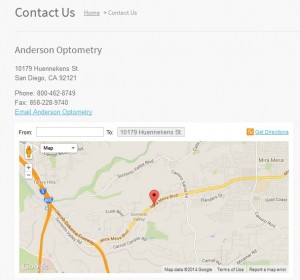 A successful online marketing strategy for your optometry business starts with a great website. What makes a website great? An informative and easy-to-use website provides a great user experience and enables you to get the maximum ROI from your online marketing budget.
A successful online marketing strategy for your optometry business starts with a great website. What makes a website great? An informative and easy-to-use website provides a great user experience and enables you to get the maximum ROI from your online marketing budget.
The Basics of a Great Website
A successful website for an optometrist should provide current and potential patients with all the information they need to make decisions, schedule appointments, and educate themselves. When building a website for your optometry practice, start by making key information easy to find.
Key information includes:
- Your Name & Business Name
- Your Office Address (a map is great too)
- Your Phone Number
- A “Contact Us” Page
- Social Media Links
 A great spot to put all this information is at the top of the page or at least above the fold. A “Contact Us” page directs website visitors to one spot where all the information for your optometry office is located (see example).
A great spot to put all this information is at the top of the page or at least above the fold. A “Contact Us” page directs website visitors to one spot where all the information for your optometry office is located (see example).
After ensuring that all your contact information is clearly visible, write content that shares who you are. This information is essential for attracting new optometry patients. In addition to writing a home page that gives information about who you are, you can include additional pages that include a doctor biography (include leisurely activities so it doesn’t sound too stiff), staff biographies, and the story of your practice. Along with wanting to know who you are, potential patients want to know what you do and what services you offer. Highlight your most popular services on your home page and create a “Services” page that discusses your popular services and any special service you offer. When writing content, focus on why your optometry practice is the best choice by sharing what makes your practice different and better than your competitors. For example, if you offer cutting-edge glaucoma testing, highlight how that makes your practice unique. Lastly, include video on your website to increase website visit times and to convey more information. Research shows that online visitors stay on websites that have video longer than websites that don’t have video. Also, video conveys more information in a shorter amount of time.
1. Simplify Navigation
A common mistake that business owners make is overcomplicating their website. As an optometrist looking to retain and attract patients, you want to make the online user’s experience pleasant and simple. The easiest way to do this is by having a simple, straightforward website. Overloading your website with everything about your practice and every service you offer will overwhelm a potential or existing patient. Focus on the essentials for your navigation. For example, a clean navigation bar will likely only have 5-7 tabs. The navigation can extend below these tabs if necessary, but a good rule is to keep your top level navigation to one row. Try to categorize your tabs into sections if you need to consolidate them.
2. Multiple Points of Contact
Enabling website visitors to contact you from any page or any spot on your website is essential for converting visitors into patients. Make it easy for people to contact your optometry practice by putting your phone number at the top of each page. A best practice is to provide email contact options as well for when patients may not be able to call right away.
3. Decrease Load Time
Don’t overdo it with graphics, images, videos, charts, apps, etc. on your website. Avoid having a flash-based website. Keeping the load time to a minimum is imperative to keeping people on your website. In many cases, a user will simply abandon a website that takes too long to load and go back to the search results to find another optometrist.
4. Responsive Design
With advancements in smartphone and tablet technology, people are using more devices throughout the day. Research shows people often use multiple devices to search online as well. For instance, a potential patient may begin their search for an optometrist on their desktop computer, continue searching on their laptop or tablet, and then finally look up the exact location of the optometrist and call from their smartphone. A website must be responsive to the type of device the person is using to create a great user experience.
5. Review Metrics Tell the Truth
You have followed all the steps listed above: what’s next? It’s time to evaluate your website analytics. Begin by looking at the “Bounce Rate.” Less than fifty percent is the goal. Anything over 50% tells us that a particular page is not providing what people are looking for or is not optimized right. Next, review average time on site (a.k.a. “Average Visit Duration”) to see how long people are staying on your website. The higher the average visit time, the better your website is designed and the better the quality of information you are providing. In addition, look at the number of “Page Views” and “Pages Viewed per Visit.” Both of these will relay the relevance of your website to what users are searching for online.
Once you have reviewed the metrics, make any necessary changes to improve the metrics. If a particular page has a high bounce rate, change up the page. Maybe the title is misleading or the content doesn’t reflect what the title implies. Metrics will help to fine-tune your website for maximum usability.
6. Get Feedback
Don’t be afraid to ask for feedback. If there is one thing everyone has, it’s an opinion. Ask friends, families, and colleagues for feedback on your website. If your local market has a high senior citizen community, ask your senior friends and relatives what they think of your website. If your neighborhood has a large population of young families, ask friends that are young mothers and young fathers to review your website. Constructive, ongoing feedback is a great tool for giving you the knowledge to keep your optometry website relevant and successful.
 Rachel Cunningham is a Marketing Content Writer at iMatrix, a provider of affordable web marketing solutions for small, practice based businesses. She earned a Master of Arts degree in English from CSU Long Beach and a Bachelor of Science from Boston College in General Management. Rachel is experienced in writing content optimized for search engines and users, creating engaging content for social media, and crafting articles about SEO and social media marketing for small businesses.
Rachel Cunningham is a Marketing Content Writer at iMatrix, a provider of affordable web marketing solutions for small, practice based businesses. She earned a Master of Arts degree in English from CSU Long Beach and a Bachelor of Science from Boston College in General Management. Rachel is experienced in writing content optimized for search engines and users, creating engaging content for social media, and crafting articles about SEO and social media marketing for small businesses.





